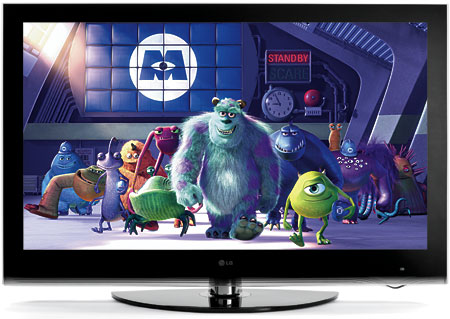LG 60PS80 Plasma HDTV
Calibration Sensation
The drop in the prices of flat-panel HDTVs during the past few years has been dizzying. While the news about this may be noisiest on the LCD side, the footsteps you hear are plasma racing back to stake its claim to the booty.

Case in point: LG. Earlier this year, we reviewed the LG 50PG60 (Home Theater, January 2009), a 50-inch set priced at $2,700. Not a bad deal—at the time. But its replacement, the 50PS80 now goes out the door at $1,800. And the larger 60PS80, our subject here, will set you back $2,900. You get a bigger picture for just $200 more than a smaller set from the last generation of LG plasmas.
Even with their lower prices, the new LG plasmas now offer a truckload of Internet content, including major players like Netflix, YouTube, and VUDU. But all the Internet content on the planet doesn’t matter without a great high-definition picture. That’s why we’re here.
Nosing Around
While the 60PS80 isn’t ultra thin, it has a slimmer than usual look. The screen glass blends smoothly into the black border, and the outer edge is narrow. The stand generously swivels about 30 degrees. As with all plasmas, the glass screen is highly reflective. The panel also emits a very slight buzz, but it was inaudible when I sat 10 feet away.
The video and audio inputs and outputs are split between the back and side panels. There’s also a USB port for accessing photos and MP3s from USB storage devices, and a LAN terminal for a link to a network or the Internet.
We rarely have much to say about the audio systems in flat-panel sets, but the LG’s is one of the best I’ve heard. While it won’t tempt an audiophile or a reasonably critical Joe or Jane to toss out a good home theater audio system, it won’t annoy them, either.
According to LG, when the 60PS80 receives 1080p/24, it either converts it to 1080p/60 by adding 3:2 pulldown or repeats each frame and displays at 48 hertz (Film mode). In other plasmas we’ve reviewed, 48 Hz produced noticeable flicker, and we did not engage that mode here.

The LG 60PS80 is THX certified. There are seven preset Picture modes, including THX Cinema and two Expert modes: Expert1 and Expert2. Except for THX Cinema, the picture settings in six of the modes are all fully adjustable by both mode and input. You can change the Expert modes to ISF Day and ISF Night modes if an ISF technician calibrates them as such and locks them in.
The THX Cinema mode locks out all the video controls except Aspect Ratio. In theory, you should be able to select THX and get an accurate and properly set-up image from the get-go. But not only was the THX mode’s gray scale inaccurate and non-correctable from the user menus, its fixed brightness and contrast adjustments were also incorrect. Digital video has a brightness range of 256 steps, from zero to 255. In video, we use the range of 16 to 235, with the remainder reserved as headroom. The LG’s THX mode limits the visible range to 21 to 234.
This doesn’t sound off by much, so why is it a limitation? We generally recommend that you set the controls so that blacks are visible down to around 17 or 18, and whites to at least 240, although some of us choose to go even higher, to perhaps 250. (These settings are easy to make, when the Brightness and Contrast controls are accessible, by using the Dynamic Range High and Dynamic Range Low patterns on the Spears & Munsil High Definition Benchmark Blu-ray Edition.) A bottom end cutoff of 21, as I had here, produces the illusion of slightly better blacks. With a white cutoff level of 234, a manufacturer can squeeze a little more brightness from a set, since this is accomplished by increasing the white level/contrast control setting. But if you allow brightness levels above 235 to be visible, you’ll also see any real information above the 235 peak white standard that might be present in sources. They shouldn’t include information above 235, but they sometimes do, which means that you could lose detail at the brightest levels with an abrupt 234 cutoff. A dark level cutoff of 21 could also shave off a bit of deep shadow detail.
- Log in or register to post comments




















































